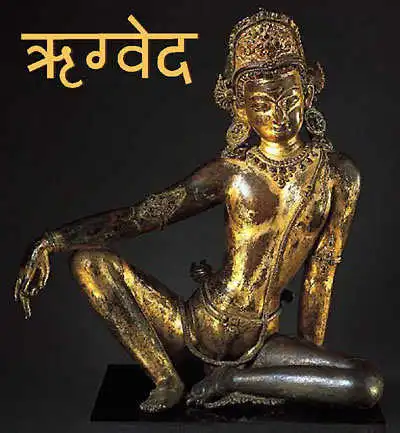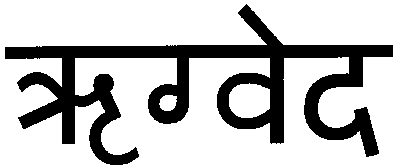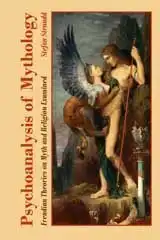
The Creation in Rig Veda 10:129The English Versions
English Versions of Rig Veda 10:129The Rig Veda (which can be translated to something like Verses of Wisdom) is a massive body of texts, divided into ten part, refered to as mandala, which in turn consist of numerous hymns. The first Western translation of any part of it was to Latin, by Friedrich August Rosen in 1830. The first complete translation was in English, made by H. H. Wilson, who published it in six volumes over the years 1850-88.
The year after the release of H. H. Wilson's last volume, in 1889, another complete translation into English was published — that of Ralph T. H. Griffith. Both have had later editions, revised by later indologists. The Wilson and Griffith works are still the only complete English translations. There's not a myriad of complete translations into other Western languages, either. In 1951-57, Karl Friedrich Geldner published a German version, which was used for a Russian version in 1989-99. So far, that's it. As for the English versions, they were heavily dependent on the Sanskrit edition of the Rig Veda compiled by Max Müller between 1849 and 1874, whereof the 10th mandala was published in 1862 (Rig-Veda-Samhita : The Sacred Hymns of the Brahman, volume 4). Müller was also editor of the 50 volumes Sacred Books of the East, published between 1879 and 1910, containing translations of most Asian classics of philosophy and religion. Although Max Müller's Sanskrit edition of Rig Veda doesn't include an English translation, except for fragments in comments and footnotes, he did publish an English version of Rig Veda 10:129 in his book A History of Ancient Sanskrit Literature from 1859. The most frequently used English translations of that hymn today are Griffith's version and that of A. L. Basham in The Wonder That Was India from 1954. In this presentation of Rig Veda 10:129, I use those as well as Max Müller's, H. H. Wilson's, and a few others for comparison. They are not that different, but where they diverge there's reason for caution, especially where fundamental ideas contained in the hymn are concerned.

The 19th century, which brought us many translation of classics from around the world, was one of industrial imperialism and Christian missionary activities expanding all over the globe. Anthropology and ethnography accompanied these ambitions closely. For example, the fact that the pioneering transmittance of the Indian classics was done in Britain is of no surprise, since in those days India belonged to the British Empire. The British were curious about the exotic Indian culture they regared as part of their domain, and the scholars were genuinely impressed by what they found. But they came from the Empire and they were molded by a Christian society, so they perceived and described their findings accordingly. In spite of their admiration for Eastern traditional thought, they continued to regard other cultures and religions as primitive in comparison to their own, as if not yet having reached the same level of evolution. Max Müller, who was quite instrumental in presenting Indian and other Eastern classics to the West, expressed a firm belief in monotheism as an expression of a more advanced human mind than that of polytheism — but he did oppose the sort of Darwinian idea that it could not be fathomed by others than later generations of humanity. In the Rig Veda, he saw several examples of monotheism from times preceding the establishment of that idea even in the Christian world. Therefore, he warned against assuming that the development from polytheism into monotheism, which might be accurate for the European history, would readily apply to the East. He compared what he called the Semitic tradition to that of the Aryan in ancient India: "Whereas the Semitic nations relapsed from time to time into polytheism, the Aryans of India seem to have relapsed into Monotheism. In both cases these changes were not the result of a gradual and regular process, but of individual impulses and peculiar influences." (A History of Ancient Sanskrit Literature, p.558-9) Still, in his relation to the texts he studied, he proved quite convinced of monotheism as intellectually superior, which may be why he spelled it with a capital initial letter but polytheism not, in the quote above. It's particularly evident in his comments on Rig Veda 10:129 in the same book (p. 559-68). The other English translators were from the very same epoque and society, so the existing complete versions of Rig Veda must be regarded with this in mind. These men from the same society are likely to have interpreted Rig Veda in a similar fashion, which may in parts deviate substantially from the intentions of the original texts — as well as from how we would understand them, if we were to make independent translations today. Due to its popularity, the Rig Veda 10:129 has been translated several times since the 19th century. Frequently used translations in texts on the hymn are those by A. A. Macdonell (Hymns From the Rigveda, London 1922), A. L. Basham (The Wonder That Was India, London 1954, p. 247-8, with later revisions), and Wendy O'Flaherty (The Rig Veda: An Anthology, 108 Hymns Translated from the Sanskrit, Harmondsworth 1981). The most recent complete translation of the whole Rig Veda into English is by Stephanie Jamison and Joel P. Brereton, published in 2014. It's the first time in more than a hundred years that the classic has been translated to English in its entirety.
Table of Seven English Versions of Rig Veda 10:129The Creation in Rig Veda 10:129The Paradox of Origin
MENUCreation Myths Around the WorldHow stories of the beginning began.
The Meanings of MythologyTheories through history about myth and fable.
Archetypes in MythsThe mythological symbols and what they stand for.
The Logics of MythPatterns of creation.
CREATION MYTHS IN DEPTHCreation in Rig Veda 10:129The paradox of origin, according to an Indian myth.
Genesis 1The first creation story of the bible scrutinized.
Enuma ElishThe ancient Babylonian creation myth.
Xingu Creation of ManThe insoluble solitude of gods and humans.
ContactAbout Cookies
ON MY OTHER WEBSITESPsychoanalysis of MythWhat Sigmund Freud and C. G. Jung thought about myths, their origins and meanings.
Myth of CreationAn introduction to the subject of creation myths and the patterns of thought they reveal.
Cosmos of the AncientsWhat the Greek philosophers believed about the cosmos, their religion and their gods.
Life EnergyThe many ancient and modern life force beliefs all over the world explained and compared.
TaoisticTaoism, the ancient Chinese philosophy of life explained. Also, the complete classic text Tao Te Ching online.
|
 Archetypes of Mythology
Archetypes of Mythology Psychoanalysis of Mythology
Psychoanalysis of Mythology Cosmos of the Ancients
Cosmos of the Ancients Life Energy Encyclopedia
Life Energy Encyclopedia Sunday Brunch with the World Maker
Sunday Brunch with the World Maker Fake Lao Tzu Quotes
Fake Lao Tzu Quotes Stefan Stenudd
Stefan Stenudd